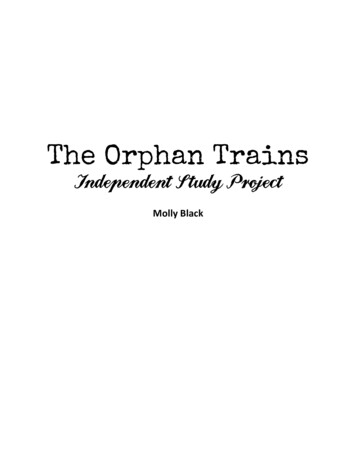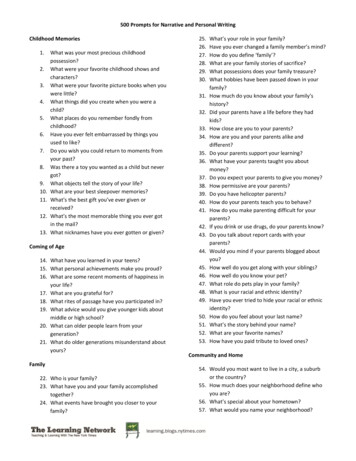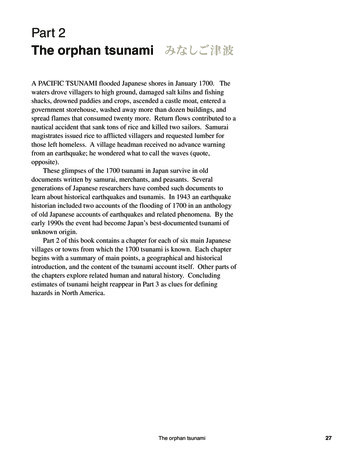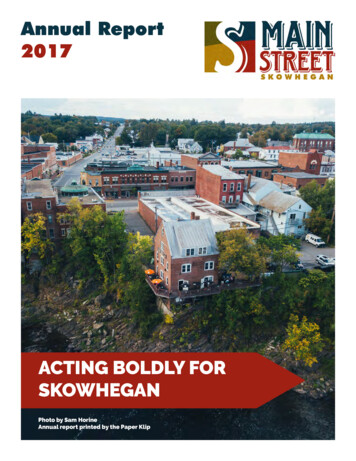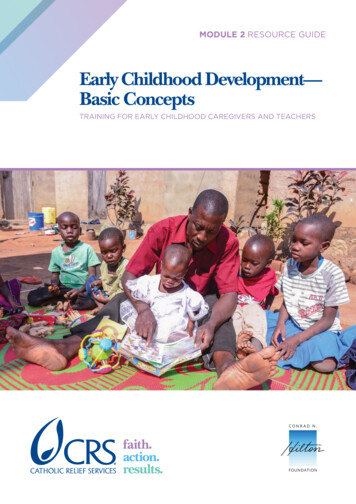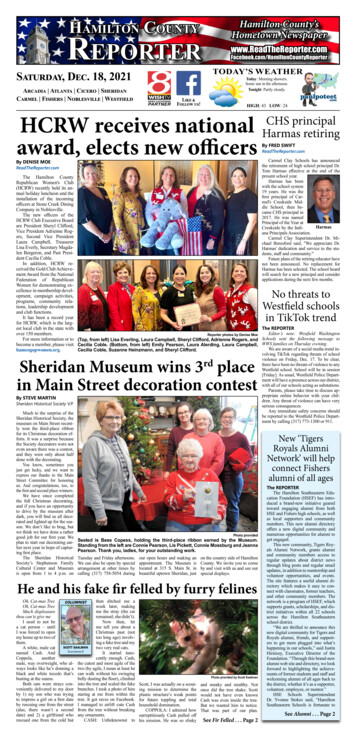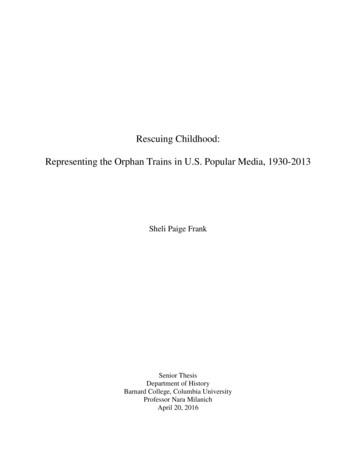
Transcription
Rescuing Childhood:Representing the Orphan Trains in U.S. Popular Media, 1930-2013Sheli Paige FrankSenior ThesisDepartment of HistoryBarnard College, Columbia UniversityProfessor Nara MilanichApril 20, 2016
Frank 2Table of ContentsAcknowledgements .3Introduction . .4Chapter OneWhere Have All the Orphans Gone? The Sound of Silence in Orphan Train Media, 1930-1960s .14Chapter TwoYesterday’s Youth: 1970s Crime, Race, and Urban Panic Reimagined in Orphan Train Media 27Chapter ThreeHow Child Abuse Scandals, Stranger Danger, and Evolving Foster Care Policies Shaped MediaPortrayals of Orphan Trains in the 1980s and 1990s 40Conclusion . .60Bibliography .68
Frank 3AcknowledgementsI wrote this senior thesis with the help and encouragement of many extraordinary individualswho gave freely of their talents and time to see me through every step of this ambitiousundertaking.Thank you to my thesis advisor, Professor Nara Milanich, for the hours she spent helping meshape my topic, locate pertinent secondary sources, and clarify my writing. Thank you also,Professor Milanich, for your continued encouragement and willingness to assist me at each levelof the writing process, from helping me work through an early idea for a chapter to reading myfinal drafts. You made yourself available whenever I needed help, and I particularly appreciateyour quick responses to my emails and your line-by-line edits that kept me on course.A special thanks to Professor Stephen Tuck of Pembroke College, Oxford University, for soreadily volunteering your time to help me develop the early research stages of my thesis while Iwas studying abroad last year. Your kind, erudite guidance through my six orphan train essaysand Orphan Train Appendix laid the foundation that enabled me to begin my thesis with a veryclear idea of what I wanted to explore and the best path to take toward the realization of my goal.Your mentoring on this topic was a highlight of my Oxford experience.A final thanks to my family and friends for their patience and encouragement throughout thisprocess, and in particular to my mother, Cynthia, for reading and watching any and all orphantrain media with me and sharing my enthusiasm for this little-studied piece of American history.Can’t wait for our celebratory trip to the National Orphan Train Museum in Concordia, KS,Mom!
Frank 4Introduction“Your Honor, sir, I have six fine children, but since my husband died last year ourstruggle has been difficult, and my children have been exposed to the temptations of thestreet. I have done my best, but it’s unable I am to both feed them and protect them fromdanger.” She paused and took a deep breath. “So I have asked Reverend Brace to send allmy children west to be placed in homes with good people who can give them what Ican’t. Please, sir, it’s begging you with all my heart I am that you allow Michael to gowith his brothers and sisters.”1As the judge very briefly debates whether or not to send 11-year-old pickpocket MichaelKelly to rot in Tomb’s Prison, it is Mrs. Kelly’s impassioned plea and, more so, her decision togive up all her children in the hope that each will find a better life, that tip the scales in favor of asecond chance for Mike. The judge’s ruling in Mike’s favor and Mrs. Kelly’s sacrifice introduceJoan Lowery Nixon’s seven-book series, Orphan Train Adventures, 1980s and 1990s children’sbooks that follow Mike and his five siblings in their new homes out west. It seems unbelievable,pure fiction, that a loving mother would send all of her children far away to go live withstrangers, but Mrs. Kelly is representative of a large group of very real immigrant parents andasylum caretakers who sent their children and charges, respectively, west on orphan trains insearch of an opportunity for a better life.In New York City of the 1850s, where Nixon’s story and the actual historical OrphanTrain Movement began, homeless children roamed the streets begging for food, some, not unlikeNixon’s Michael Kelly, desperately resorting to thievery purely to feed themselves and theirfamilies.2 As Mike could have been, thousands of young New York pickpockets and “StreetArabs,” often immigrants themselves or the children of new immigrants and some of them asyoung as five years old, found themselves locked up with adult criminals. 3 Others banded1Joan Lowery Nixon, A Family Apart: Orphan Train Adventures #1 (New York: Bantam Doubleday Dell, 1987),43-44.2“The American Experience: The Orphan Trains – About the Program,” Pbs.org. Web.3Ibid.
Frank 5together to form gangs that became a growing problem for city police. In 1853, a young ministernamed Charles Loring Brace, recognizing the plight of these young vagrants, founded theChildren’s Aid Society to help provide what he saw as the only solution for these destitutechildren: “to send them away to kind Christian homes in the country.”4 Thus began the OrphanTrain Movement, a seventy-five-year social experiment in which the Children’s Aid Societyplaced roughly 250,000 children in forty-eight states.5 Aware of the need for laborers in ruralAmerica, especially in the expanding west (now considered the Midwest), Brace believedfarmers would be eager to adopt the homeless urban orphans not only as a source of extra laborbut also to become an integral part of their families. Brace’s program became the “forerunner ofmodern foster care.”6The “placing out program” of the Children’s Aid Society would spawn multiple similarchild migration movements, including a comparable placing out program sponsored by the NewYork Foundling Hospital which placed over 30,000 children during its tenure.7 Unlike theChildren’s Aid Society, the Foundling Hospital, a Catholic agency, configured “baby trains” ofmuch younger children. In fact, the institution actually left in its foyer a bassinette where parentscould anonymously drop off their children. Many of these birth families willingly sent theirbabies and toddlers out west to find new homes. Before the babies were sent away, the agencysecured homes for them, and in each case a number was tagged to the child’s clothing to coincidewith the number given to the family who had promised to adopt him or her.8“The American Experience,” Pbs.org.Suzan Sherman, "The Nearly Forgotten Phenomenon of the Orphan Train: A Dispatch from the Annual'Celebration’ of Riders, Descendants, and the Enthusiasts Who Love Them," Gettysburg Review 24 vol.3 (2011),Humanities Full Text (H.W. Wilson), EBSCOhost: 389.6“The American Experience: The Orphan Trains,” Pbs.org.7Sherman, "The Nearly Forgotten Phenomenon of the Orphan Train,” 389.8Ibid, 391.45
Frank 6The majority of children sent west on orphan trains, however, were sent via the morecontroversial orphan trains of the (Protestant) Children’s Aid Society. These children were notmatched with families before they left. 9 Instead, one to three caretakers accompanied 30 to 40children, ranging in age from babies to teenagers, on each train ride from New York City to thechildren’s as of yet unknown new homes “out west.”10 When they reached each western stop, thecaretakers would clean up the children and bring them to the meeting place, often a local church,where the children were lined up on some sort of stage and, quite literally, “Put Up forAdoption.”11 Children with special talents like singing and dancing were encouraged to performfor a crowd of onlookers, many of whom came just for the spectacle.12 Often, children wereviewed like livestock; prospective adoptive parents, total strangers, felt their muscles andinspected their teeth, in search of free labor instead of a new son or daughter.13Once chosen, children were often separated from their biological siblings, and whilesiblings were sometimes chosen by families in the same area and allowed to visit each other, justas often they were chosen at different stops then separated by many miles and left no choice butto “lose track of each other completely,” not unlike what occurred at American slave markets,which overlapped with the Orphan Train Movement by a few years.14 Children not chosen at thefirst stop on any given trip were left wondering if something was wrong with them as theyclimbed back aboard the train to try again in the next location. Children who were chosen had tolive with strangers, sometimes on remote farms far from any neighbors. Some were adopted bynon-English speaking families in small Midwest communities of Germans, Norwegians, Danes,Sherman, "The Nearly Forgotten Phenomenon of the Orphan Train,” 391.“Orphan Train History,” National Orphan Train Complex: Preserving the Past for the .12Sherman, "The Nearly Forgotten Phenomenon of the Orphan Train,” 391.13“Orphan Train History,” National Orphan Train Complex.14Ibid.910
Frank 7and Swedes, or in the French-speaking state of Louisiana.15 The number of orphan trains sentwest declined rapidly in the 1920s, due in large part to the growing amount of state legislationrefusing entry to out-of-state child wards.16 The orphan trains ran in smaller numbers through the1920s, and the last train ran in 1929, the same year the stock market crash and the GreatDepression shook America.17This thesis will not explore the Orphan Train Movement itself; rather, it will explore therelationship between 20th century portrayals of the orphan trains in media and the panics aboutchildhood occurring during the time in which these media appear. I frequently use the term“orphan train media,” and for the purposes of this thesis, that term refers to representations of theOrphan Train Movement after the movement ended (in 1929) in journal articles, novels, youngadult and children’s novels, children’s nonfiction, television episodes, and film. This thesisargues that the orphan trains have been mobilized in media throughout the 20th century byviewers and writers alike in search of a solution to modern anxieties about childhood. Thepopularity of orphan train representations in media from 1930 to 2013 has grown from a time oftotal silence to one of extraordinary public interest. This narrative reflects changing views aboutthe welfare of American children and, in particular, anxieties about juvenile delinquency, childabuse, and the extent to which current foster care policies are acting in the best interests of thechild. Orphan train media not only reflect current panics about childhood, but more significantly,the orphan trains themselves appear as a theoretical solution to modern anxieties.Although no one in the 1970s, 1980s, or 1990s outwardly suggested a modern orphantrain, the representations did espouse modern family values and timely commentary onSherman, "The Nearly Forgotten Phenomenon of the Orphan Train,” 391-2.“End of an Era: Orphan Train History,” National Orphan Train Complex.17“Orphan Train History,” National Orphan Train Complex.1516
Frank 8childhood, and in these similarities and their presentation of the orphan trains, they suggest that asolution to modern day child-related concerns may be found in the orphan trains. Over the courseof the 20th century, as panics about dangerous children shifted to panics about lost childhood andadult abuses of children, so did representations of orphan trains shift from their originalpresentation as a solution to urban decay to more complicated portrayals. The most popularorphan train media to date is Christina Baker Kline’s novel Orphan Train (2013), aimed at anadult audience and portraying the orphan trains as a migration of misery that sent the majority ofits riders to abusive families worse than what they had left behind on the streets of New York.The chapters in this thesis will move chronologically, beginning with the year 1930, theyear after the last orphan train ran, and culminating in 2013 with a brief discussion of Kline’sbestseller. The first chapter covers the 1930s-1960s, thirty years of a near radio silence in whichthe Orphan Train Movement was displaced in media and history, overshadowed by moreimmediate concerns about poverty during the Great Depression and orphans in Europe duringand after World War II. The second chapter of this thesis examines the 1970s and the firstappearances of orphan trains in popular media as well as how they are representative of panicsabout gangs and dangerous youths in that decade. The third and final chapter discusses theburgeoning emergence of orphan train literature in the 1980s, particularly as a lens throughwhich to view the new, growing panics about stranger abductions, child abuse, and theshortcomings of the American foster care system.My thesis does not directly contribute to one area of academic discourse, as to myknowledge there have not been any other studies about the relationship between 20th centuryorphan train media and evolving panics about childhood. There is scholarly literature on theorphan trains and other child migration movements, but I did not draw significantly on any of
Frank 9those sources as my thesis is focusing on the representations of the orphan trains in popularmedia. Therefore, I drew on popular media representations of the orphan trains which I read injuxtaposition to scholarly literature about the history of American childhood and panics aboutchildhood in the 20th century. I did not find any one study that encompassed all of the shiftingpanics about childhood from 1930-2013 so I drew my information from numerous studies ofdifferent panics about childhood during the decades each chapter spans.The exception is Steven Mintz’s Huck’s Raft: A History of American Childhood.Although Mintz’s book is a more general overview of American childhood which I needed tosupplement with more detailed analyses, the text did help me identify patterns in child-relatedpanics and form a broad picture of shifting views of threats to American childhood. I usedMintz’s book to identify which key panics I should research in more depth and, while I waswatching and reading orphan train media, to help me recognize these connections when theyappeared. I also used his book to structure my chapters thematically and chronologically. Fromthe fifteen additional secondary sources I gained more specific information about some topicsMintz mentioned more broadly, like fears about youth gangs during the 1970s and the sexualabuse of children in the 1980s. I compared these more detailed sources to my orphan train mediain order to find specific connections between the two and determine what solutions variousorphan train media were proposing for the modern panics they addressed.As the Orphan Train Movement primarily focused on children, so are many, although notall, of the sources for this thesis geared to young audiences. The sources in support of this thesisinclude both nonfiction and fiction, some novels and scholarly articles, some film and TVepisodes. While a majority of the media feature young protagonists and target young readers andviewers, there are other sources intended for adults. When viewing and reading these sources for
Frank 10the first time, I found the greatest variation in the treatment of the orphan trains happened acrosstime periods in keeping with specific trends rather than in terms of the target audience. However,there is a minor variation in the way some information is presented to children versus adults. Theonly substantial difference in presentation of orphan train media based on audience occurredduring the 1980s and 1990s, a time period covered in my third chapter. I will discuss the possiblesignificance of this difference later in this introduction when I outline Chapter Three.When reading and evaluating my secondary sources, I examined orphan train media forany commonalities and differences, finding far more of the former than the latter. The strongcorrelation between shifting 20th century panics about childhood and the media portrayals oforphan train riders and their experiences led me to structure my chapters thematically as well aschronologically. My first chapter will explore the significance of the near radio silence in orphantrain media from the 1930s to the 1960s. Within this first chapter, I will consider the fewexceptions to this silence, including the nonfictional 1951 Good Housekeeping article “GoodBoy,” about an actual orphan train rider’s experience, and a 1953 Hollywood “B” movie,Scandal at Scourie, very loosely based on the “Good Boy” article.Chapter Two will study orphan train representations in the 1970s, focusing primarily ontwo sources: a 1974 academic article defending Brace’s mission to send children west on orphantrains called “The Children’s Migration” by Annette Riley Fry, and the 1979 TV film OrphanTrain starring Jill Eikenberry, Kevin Dobson, and Glenn Close, based heavily on a 1978 novel ofthe same name by James Magnuson and Dorothea G. Petrie. Both sources emphasize the squalorof the New York City streets and the unforgiving life of poverty, gang culture, and crime thatwould consume the children were they not sent west to, as it was assumed, better homes. Whenread in conjunction with secondary literature about 1970s moral panics, these portrayals of the
Frank 11orphan train reflect mounting concerns in the 1970s about gang culture and the relationshipbetween derelict youths and urban decay. However, the orphan trains arguably emerge in mediabecause their all-white riders provide a way to address modern concerns about street culturewithout also having to discuss the added concern about dangerous youth: that they werepredominantly people of color.18Media interest in the orphan trains grew over the course of the 20th century as evidencedby the relative boom in orphan train representations in television, film, and literature in the1980s-1990s. The sources for my third and final chapter include two episodes from two popularwestern television series, the 1989 “Orphan Train” from Guns of Paradise and the 1994 “OrphanTrain” from Dr. Quinn, Medicine Woman. Literary sources include Andrea Warren’s 1994biographical children’s book Orphan Train Rider: One Boy’s True Story and a number of booksfrom Joan Lowery Nixon’s two young adult series featuring the Orphan Train Movement:Orphan Train Adventures (7 books) and Orphan Train Children (4 books).As the 1980s panics about child abuse, fears of stranger abduction, and concerns aboutfoster care policy were at the forefront of discussions about childhood, so did representations ofthe orphan trains bring to the forefront similar concerns in their historical context. In orphan trainmedia there were a few new themes that emerged in keeping with the larger concerns aboutchildren during those decades. One recurrent theme was that the fact that children were taken inby “strangers” out west was, within itself, an added danger. Another common theme was that theorphan trains often separated siblings to painful ends; this reality was especially relevant tochanging foster care policies that sought to determine how much weight to place on familyreunification as opposed to adoption by new families. Finally, child abuse, a major concern of18John M. Hagedorn, World of Gangs: Armed Young Men and Gangsta Culture (Minneapolis, MN, USA:University of Minnesota Press, 2008), xiii.
Frank 12the 1980s and 1990s, appeared frequently in orphan train media, both in the orphaned riders’new foster homes and back in New York City.Among the instances of child abuse in orphan train media of the 1980s and 1990s theonly noticeable difference I found concerned how panics about childhood were presented tochild audiences as opposed to adult audiences. Joan Lowery Nixon’s novel Caught in the Act isintended for young readers, yet it includes graphic descriptions of physical abuse throughout, asMike’s foster father beats him until blood seeps through his shirt.19 Physical abuse and neglectare present in a number of orphan train media intended for children; however, sexual abuse isjust referenced in more adult orphan train media of the age. The 1979 Orphan Train film is basedon a novel intended for adults, and both film and book include the description of a young girlrescued from a life of forced prostitution and molestation.20 Similarly, the episode of Dr. Quinn,Medicine Woman featuring the orphan trains also has a young female rider nearly forced intoprostitution, this time out west, although she is saved before the sexual abuse can begin.21 Dr.Quinn was not rated in America, but it features an adult protagonist, and some of its episodes arerated M in Australia (not for an audience under age fifteen), suggesting more mature subjectmatter.22 There was a significant shift during the 1980s and 1990s towards the protection ofchildren from abuse, which stance could explain this distinction, but with the comparatively fewsources of orphan train media that I have at my disposal, I cannot reach a definite conclusion,only acknowledge the discrepancy.19Joan Lowery Nixon, Caught in the Act: Orphan Train Adventures #2 (New York: Bantam Doubleday Dell, 1988),134.20Orphan Train, directed by William A. Graham (1979; CBS Direct to Television Movie).21“Orphan Train.” Dr. Quinn, Medicine Woman, CBS Columbia Broadcasting System (Los Angeles, CA: WNBC,January 29, 1994).22Internet Movie Database (IMDb): “Orphan Train.” Dr. Quinn, Medicine Woman, CBS Columbia BroadcastingSystem (Los Angeles, CA: WNBC, January 29, 1994).
Frank 13As interest in the orphan trains increased over the course of the 20th century, so didrepresentations of the orphan trains, particularly evidenced in the growth of orphan trainliterature, film, and TV presence in the 1980s and 1990s. While these portrayals show anincreased interest in the Orphan Train Movement, however, they are products of the times inwhich they were produced. In each example of orphan train media presented in this thesis,themes and panics about childhood and youth culture determine what aspect of the orphan trainexperience is highlighted and how the stories, both fictional and nonfictional, are recounted. Bystudying these trends in orphan train media over the course of the 20th century, we learn aboutthe times in which they were created, and it is those messages that are worth analyzing, perhapseven more than their highly subjective and sometimes even inaccurate representations of theOrphan Train Movement, the largest children’s migration in history.23 What we do learn,however, from these representations, is that the orphan trains are remembered through time as asolution, not always ideal, but nonetheless a relevant system worth examining in the search tohelp modern youths in need.Andrea Warren, “The Orphan Train,” Special to the Washington Post, 1998, on/nov98/orphan.htm, Web.23
Frank 14Chapter OneWhere Have All the Orphans Gone?The Sound of Silence in Orphan Train Media, 1930-1960sIn the 1946 Christmas classic Miracle On 34th Street, even the most skeptical of children,Susan Walker, believes in Santa Claus after Macy’s self-proclaimed Kris Kringle breaks intofluent Dutch to converse with a newly-adopted Dutch war orphan. The joy of the orphan’sadoptive mother is eclipsed only by the little girl’s delight, as she climbs up onto Kringle’s lap toconverse with him in her native tongue. The moment becomes even more idyllic as Kringle asksthe child what she wants for Christmas, and the girl replies, “Nothing. I have everything. I justwant to be with this nice lady.”24 In the 1940s, the face of orphans and adoptees in Americanmedia was very different from the social problem of street urchins that led Charles Loring Braceto send youthful criminals west on orphan trains for a new start.25The last orphan train had departed nearly two decades before Miracle on 34th Street cameto theatres in 1947. After the economic ruin of the Great Depression followed by an internationalwar, stories describing the plight of orphans were starting to reappear in popular media. Thistime, the orphans depicted were not dangerous, lawless, or unwanted immigrant children; rather,they were “innocents,” European collateral damage of war. As the United States grew in globaldominance, many Americans found the foreign war orphans increasingly desirable as adopteesand even believed it the financial and moral responsibility of their country to provide for theseyoung war orphans.2624Internet Movie Database (IMDb): Miracle on 34th Street, directed by George Seaton (1947; 20th Century Fox).Annette Riley Fry, “The Children’s Migration,” American Heritage 27, no. 1 (1974).26Laura Briggs and Diana Marre, International Adoption: Global Inequalities and the Circulation of Children (NewYork: NYU Press, 2009), 5.25
Frank 15In the forty-or-so years between the last orphan train ride and the beginning of popularmedia portrayals of the orphan train in the 1970s, there is scant mention in newspapers,television, or film of this large child migration. In later decades of the 20th century, the mediaoften mobilized the orphan train as an example of a solution, sometimes celebrated, sometimesdeplored, to modern anxieties about childhood. This chapter will focus on decades of orphantrain media silence with a twofold aim. The first aim of this chapter is to prove the significanceof the absence of orphan train references in popular media from the 1930s to the 1960s. Thesecond goal is to understand this media silence regarding the orphan trains by looking at how theAmerican public was viewing orphans, adoption, and later, transracial adoption from 1930-1960and to explain why the orphan trains or a similar large child migration would not have been auseful solution in this later period.The orphan trains began as a movement to integrate orphaned and unwanted city childreninto mid-western family life. By the 1930s and 1940s, the orphan trains had accomplished theirmission; their riders had grown up and been assimilated into the Midwest and South. The poor,orphaned children who once rode the orphan trains had been incorporated into the generalpopulation and did not individually or as a group stand out from the rest of Americans who wereaffected in varying degrees by the poverty and other hardships that swept America during theGreat Depression. Following the Great Depression, any knowledge of or focus on the orphanswho had ridden the orphan trains was again eclipsed by the numbers of new orphans who hadcome to take their place. As the Second World War ended and America entered the Cold War, allorphans mentioned in media were European war orphans, so the concept of “orphan” acquired aquintessentially non-American connotation. Postwar humanitarian programs were determined tosave these orphaned war children through the same means Charles Loring Brace had advocated:
Frank 16adoption by strangers. This thesis argues that the treatment of the orphan trains in media oftenmirrors the current popular and political panics about dissident youths, orphans, and foster carein America. This chapter argues that in times when there is no easy connection betweenAmerican youth and the orphans who rode west, or no connection the media is willing to admitexists, the orphan trains either disappear from popular conversation or are substantially modifiedin keeping with modern perceptions on just what constitutes an orphan.This first chapter explores forty years of relative silence about the Orphan TrainMovement and differing perceptions of orphans by dividing those years chronologically based onshifting trends. The first section of this chapter will address the years following the last orphantrain ride west, with particular emphasis on the relationship between the Great Depression,World War II, and the disappearance of any mention of the orphan trains in the media. Thestaggering number of poor and needy Americans during the Great Depression meant that urbanorphans were subsumed within the growing number of all needy children whose parents had losttheir jobs. The relative prosperity that followed the Depression and, with the advent of WorldWar II, the necessary focus on the war effort meant that poor, needy American children andorphans were no longer front page news.The second section of this chapter will examine the postwar interest in orphans,particularly the media portrayal of a “new” category of orphan consisting of European warorphans, children fathered by American GIs, and, less frequently, American war “orphans” wholost fathers to the war. A far cry from the children of immigrants who had prowled the streets ofNew York and ridden the orphan train to a new life, these war orphans were not perceived asneeding redemption or as menaces to society. Therefore, the street urchins who rode the orphantrains might not have seemed an appropriate comparison to make in media hoping to portray war
Frank 17orphans as innocents that Americans should care for and adopt. This second section will alsoaddress two portrayals of the orphan train in 1950s literature and cinema that are exceptions thatprove the rule. These two outlier sources are the 1951 Good Housekeeping article “Good Boy”by Mary McSherry with an accompanying illustration by Norman Rockwell entitled “LittleOrphan at the Train” and a loose adaptation of that article, a 1953 Hollywood “B” film Scandalat Scourie starring Greer Garson and Walter Pidgeon. This section will particularly examine thefilm, which took significant liberties in modifying the article, from changing the gender of thechild protagonist to, most significantly, changing the location of the train on which that childtraveled west. By moving the story to Canada, Scandal at Scourie further emphasized, in keepingwith the then-current perception of Americans,
Joan Lowery Nixon’s seven-book series, Orphan Train Adventures, 1980s and 1990s children’s books that follow Mike and his five siblings in their new homes out west. It seems unbelievable, pure fiction, that a loving mothe
